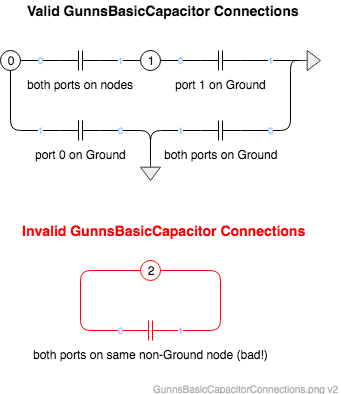GunnsBasicCapacitor - nasa/gunns GitHub Wiki

This link models an electrical capacitor in GUNNS networks and its ability to store charge as capacitance. This can be used to model RC circuits in GUNNS. This link applies its capacitance across the attached basic nodes. Nodes with an attached capacitor or similar link are called capacitive nodes; those that do not are called non-capacitive nodes.
In GUNNS, capacitance C is the change in quantity Q needed to cause a unit change in potential P.
This picture shows the ways that basic capacitors can be connected to nodes. Unlike the GunnsThermalCapacitor and GunnsFluidCapacitor links, which must connect their Port 1 to ground, the basic capacitor can connect between two non-Ground nodes. Also, unlike the thermal and fluid capacitors, you can put more than one basic capacitor on the same node.

Port Connection Rules (These are limitations on the port connection to nodes that the link enforces in run-time):
- Both ports cannot connect to the same non-Ground node.
Other Rules (These are extra rules you should always try to follow):
- A "feature" of GUNNS is that any node or nodes that are isolated from any capacitance or voltage/current sources have their voltage solve to zero. This is because non-capacitive nodes represent locations that have zero ability to store charge, when they are isolated their potential is undefined -- the GUNNS solver handles this ambiguity by setting it to zero, as if the point discharges instantantaneously to Ground. To avoid a sensor detecting zero voltage in an isolated node, add some small non-zero capacitance to the node.
Configuration Data Parameters:
- N/A
Input Data Parameters:
- malfBlockageFlag (default = false): Initial state of the blockage malfunction activation flag. NOTE: the blockage malfunction is deliberately not implemented in this link and has no effect.
- malfBlockageValue (default = 0.0, must be (0-1)): Initial state of the blockage malfunction activation value.
- capacitance (default = 0.0, must be >= 0): Initial capacitance of the capacitor. This is usually constant for most capacitors but is technically "input data" to allow for changing capacitance in a derived class modeling higher-order effects. The units of capacitance are Farads, which is not a Trick-recognized unit. In Trick-recognized units it is (amp*s/V).
- potential (default = 0): This is the intial voltage that the Port 0 node is set to. The link doesn't initialize the Port 1 node voltage.
- N/A
- N/A